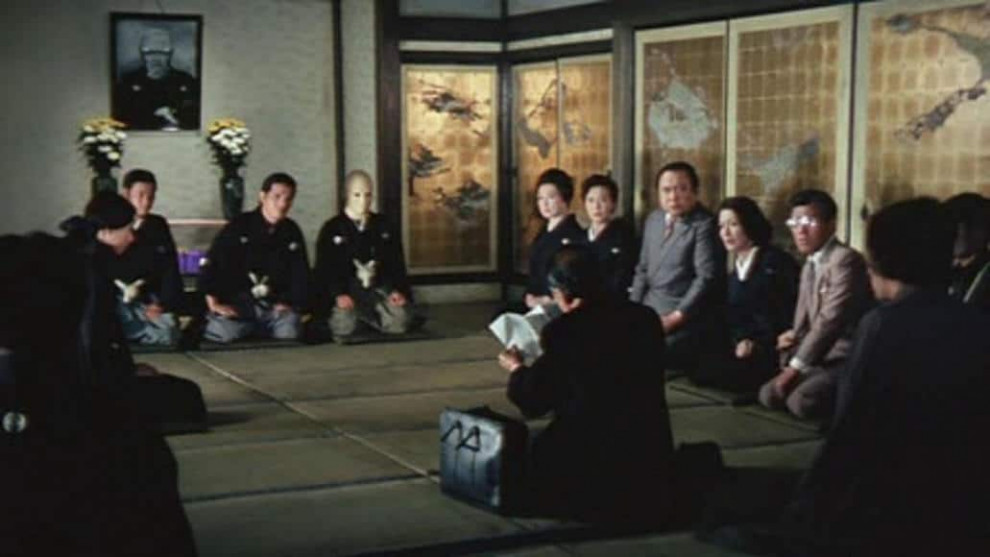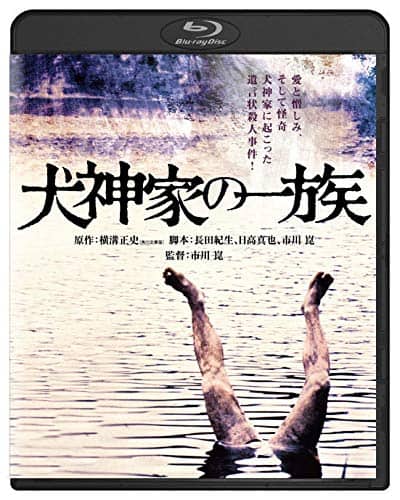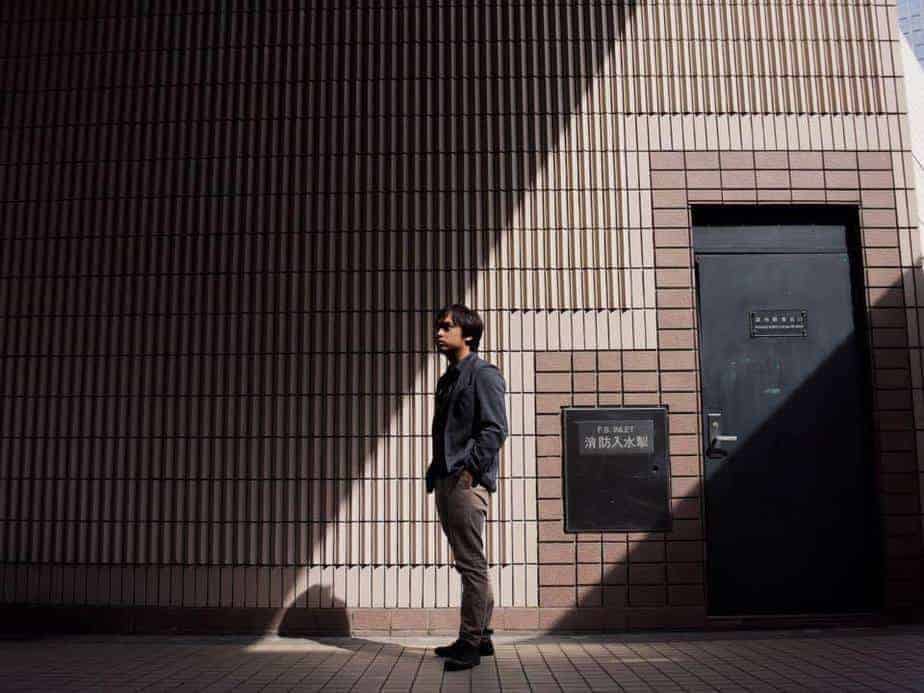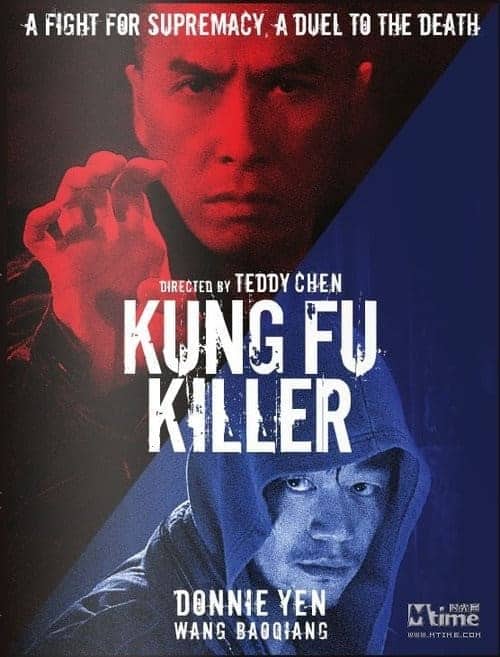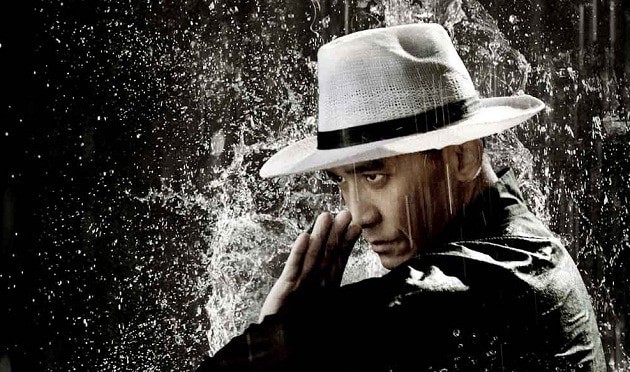By Nicholas Poly
In this article I'm going to take a peek on a double bill. The first title is Kon Ichikawa's intriguing mystery drama ‘The Inugami Family' aka ‘The Inugamis', which was released back in 1976. The second one is Masato Harada's ‘Inugami' which was released 25 years later, in 2001.
The interesting fact is the inugami ‘effect' itself, in both films, which is also the obvious link between the two titles. It must be stressed though, that the theme is presented from a completely different angle in each one of these features. This means that there is no apparent ‘technical' or ‘artistic' relation between the two films. Harada's film is nor a remake neither some kind of ‘hommage' on Ichikawa's title. Each one of the films forms a cinematic universe of its own, despite the dramatic overtones and symbolisms that reflect in both features.
Buy This Title
on Amazon by clicking on the image below
But first of all what is ‘inugami', what does it mean?
‘Inugami' (which stands for ‘dog god') is a state of spiritual possession by the spirit of a forest dog, mostly revived in the western parts of Japan. The ‘Inugami' belongs in the class of supernatural monsters, a ‘Yokai' in Japanese terms. It is also believed that this kind of possession may not have a strictly ‘evil' or vicious effect on a human, as these spirits of ‘god dogs' come in various forms. The ‘Inugami' is an inherited ‘curse' that passes on from generation to generation, within the members of a family. The person who is primarily responsible for the possession has also the power to control its effect through the affected members of the family. It's said that the ‘possessed' have the power to cause health issues to enemies or even bring wealth to those who befriend them. To make a quite long and interesting story short, we're talking about some kind of folklore superstition, a kind of deeply symbolic, supernatural state, which is quite possible to take a deadly, vengeful turn within a ‘clan'.
If you want to discover more about ‘yokai' folklore beasts in general, there is this great book called ‘The Night Parade of One Hundred Demons: a Field Guide To Japanese Yokai' written by Matthew Meyer. It's full of beautiful illustrations by the author himself, plus you will find interesting stuff about the inugami concept. There are plenty of interesting books regarding yokai monsters. Of course there is also Miyazaki's most popular celebration of forest god's in his ‘Mononoke Hime' back in 1997. A feature which should be analysed frame by frame in order to righteously explain the symbolism of the creatures Miyazaki presents. Finally, if you fancy a little bit sleazier take on the Inugami myth you may find it it in Shunya Ito's 1977 film ‘Curse of the dog god'. Though I like Ito as a director, who's mostly famous in the west for his ‘Sasori' series starring Meiko Kaji, I wasn't overly satisfied with his take regarding the ‘inugami' curse. He surely produced much better features throughout his career than that. But let's take a look into our main titles.
Kon Ichikawa
First of all, I would love to write a few words regarding the great filmmaker, Mr. Kon Ichikawa. He is most widely known to the public for his 1959 epic ‘Nobi'. But that's just a tip of an iceberg full of amazing masterpieces, literally created for every kind of cinematic taste and mood. Ichikawa himself had his own film remade 30 years later, back in 2006, under the title ‘The Inugamis'. This is no surprise as Ichikawa is widely known about his remakes on various titles during his career. In 1985, almost 3 decades after its original release, Ichikawa created a remake of his own poetic WWII chime ‘The Burmese Harp'. Moreover, one of his greatest masterpieces, which is also one of the most important and thoroughly entertaining films in the history of Japanese cinema, the blend of ‘kabuki' revenge drama mixed with pure entertainment that ‘An Actor's Revenge' is, was released in 1963. It also happens to be an absolutely stunning remake of the equally gorgeous 1937 film by the pioneer director Teinosuke Kinugasa.

Ichikawa also mastered the art of onscreen literary adaptations. For instance, his adaptation on Mishima's iconic ‘Conflagaration' in 1959 is a filmic essay on how one adapts a novel onscreen. In ‘Conflagaration' he's taking a genuine, fully symbolic, work of art in order to transform it into a solid, powerhouse cinematic statement. Hand in heart, and having watched a certain amount of his films on repeat, I dare say that even a whole volume might not be enough to describe in full detail the triumphs that Mr. Ichikawa has achieved through his creative years. Let's not forget we're talking about a spanning career that runs through 6 decades and about 90 features…the utterly rare but exact case where cinematic quantity meets quality.
Ichikawa's versatility is something unique. His amazing artistic tuition, regarding so many different aspects, shines all over his films. His impeccable skills range from costume and set design to ‘manga' storyboarding techniques. His perfect sense on using the right sounds and musical scores against the exact precise imagery make his features, most often, seem like an audiovisual marvel, to say the least. Ichikawa is a masterful entertainer, a really clever and definitely a complex one. The artist that hits all kinds of spots. There's absolutely nothing to spare. He is the one who will use every tool he has to turn on the viewer's senses to the highest volume possible. His heroes seem dignified, they seek redemption and even revenge, they often defy their limits, they resist. They become preserved, they demand spiritual enlightenment, but they are daring at the same time, ready to push their human boundaries.
After his epic triumph with the filming of the iconic documentary about the 1964 Tokyo Olympics for Toho studios, Ichikawa directed a few independent productions. There were a series of documentaries and a few dramas, including the beloved title of ‘Matatabi' (aka The Wanderers) a marvelous, metaphorical film about three ‘ronin' warriors in feudal Japan which shouldn't be missed.
The Inugami Family
In 1976, he decides that it's about time to get involved with proper studio production once again, as things in Japanese film industry went extremely tight for a vast number of first rate creators. He teams up with Kadokawa studios and directs the onscreen adaptation of the novel ‘The Inugami Clan'. This is the first film from a series of five created by Ichikawa, which involve the iconic Japanese detective Kosuke Kindaichi. This is a character originally created by the acclaimed novelist Seishi Yokomizo and followed by almost 80 absolutely classic mystery tales. Ichikawa strikes gold as ‘The Inugami Family' becomes a huge box-office success, accompanied by critical appraisal. The production values are huge and the refund is equally big. This is possibly the film which fuelled Ichikawa's engine to get going at full speed towards the next decades.
Once again, following his successful recipe of extremely complex but highly entertaining films, he manages to handle a quite big number of characters in absolute harmony, and respect the author's hierarchy, at the same time. He's so spot on balancing the ingredients of comedy – family drama – mystery – thriller in such a scale that his achievement only seems as effortlessly natural as much as impressive. Undoubtedly, Ichikawa has got exactly what it takes to accomplish this quite difficult task. We're talking about a case where the viewer has to keep up with about 15 to 17 (to be a bit more precise 10 leading family members plus 2 leading outsiders consist the very core around which the main drama revolves) characters. These very characters constantly clash with each other in various ways, in order to dominate over a family fortune case.
But let's try setting a few things in order by providing as much information as I'm allowed to give without spoiling the pleasure of watching Ichikawa's extraordinary ‘craftwork'. The truth is that if the viewer digs into the film without reading Yokomizo's novel or without a very rough sketch, there is a minor possibility of getting ‘lost'. The final conclusion is quite clear though.
The story is set around 1947. WWII has ended and the set is the small community around lake Nasu. A very wealthy and the apparent head of the Inugami family, Sahei, is ready to ‘leave' this world. Sahei (a quite Shakespearean figure for at least as much time as we get to notice him) is also the founder of a big pharmaceuticals company, which runs under his name. As we sink further into the case, we learn a few secrets, which, by the way, seem to be a bit common within the community members. There are revelations which unfold through personal discussions, regarding how he set up his business and subsequently on how he grew extremely rich and powerful in the area of Nasu. After all, providing drugs to ease the human pain during wartime, equals big profits. The opening sequence captures Sahei surrounded by a number of family members. The family lawyer, Mr. Furutachi, is ready to read the will he left behind as Sahei's body lies on the tatami, ready to take his very last breath. Except the fact that his will won't be announced yet. This happens for the simple reason that he has commanded that each and every one of the Inugami family members should be present when that happens.

The Inugami family tree is quite complex. Sahei has 3 daughters with 3 different women with whom he never got married. At some point, when the will is finally being announced, we are informed that he has a 4th one with a maid who worked inside his mansion. From the 3 apparent daughters, Matsuko is the eldest, Takeko is the second and the third one is Umeko. Matsuko and Umeko live in their father's mansion, while Takeko lives in Tokyo, with her husband, who happens to be a branch manager for the company there. The 3 daughters have 3 sons named Suketake, Suketomo and Sukekiyo except Takeko, the middle sister, has also a daughter named Sayoko. His 4th daughter has also a son named Shizuma. Shizuma's and his mother's last name doesn't belong in the Inugami visibly ‘legitimate' circle of family members. He and his mother are some kind of outcasts who do not receive any kind of approval from the rest of the family members. At least as they present them to be. Shizuma and Sukekiyo (Matsuko's son) were soldiers fighting for the Japanese army and one of the reasons Sahei's will is not read in the first place is because Matsuko is missing away from the mansion for a while. This happens in order to meet her son who made his way back from the front, wounded, carrying a nasty face disfigurement. As a result, she's bringing him back, with his face covered behind a white mask. As soon as Matsuko and her son return to the mansion the will can be read in front of every single member, as Sahei had commanded in the first place.
In the very beginning we also focus on a young girl named Tamayo Nonomiya. Tamayo is introduced as Sahei's protégée. At first we learn that she has no connection with the Inugamis. We are informed that she's just a character that Sahei felt connected with and eventually that's how she found herself inside his mansion. Of course this is not quite the case as Tamayo's presence is one of the keys for various reasons and faces within the family. This includes a hidden secret on how Sahei appeared in Nasu area out of nowhere at a young age and how he befriended a local couple there, including a strange romance. A story that goes 60 years back and which I am not going to analyze any further.

At the same time, we witness the arrival of our hero, the man that becomes our guiding light through this puzzle. Detective Kindaichi is a fairly young man, who, at first glance, doesn't quite make an impression of what some may call a stereotypical ‘detective figure'. He has a quirky spirit though, and an amazingly strong sense of what's happening around him. He certainly knows how to get into the bottom of things in his own special way. He comes along a quite gentle, discreet and trustworthy personality. He's spontaneous and a bit of a loner. I would say, for us the westerners, Ichikawa's Kindaichi is a hybrid of Detective Colombo and a bit of Holmes. He seems to drift in his own thoughts, but the truth is that's only a cover to get exactly where he wants.
Kindaichi is called by Wakabayashi, the Inugami's lawyer young assistant. Apparently Wakabayashi reads the will by himself so he writes to Kindaichi and invites him to examine a few things. There is also a hint that this certain man has a thing going on with beautiful Tamayo, Sahei's protégée. He understands that there will be lots of tribulations, so he calls the detective to have an eye on case. The thing is that Wakabayashi is the first one of the victims, as he's found poisoned inside the small ‘Nasu Inn', the place where Kindaichi's staying, while he's dropping in to have a meeting with him. Kindaichi also becomes the eye-witness of an incident concerning Tamayo's assassination, as there's an attempt to drown her by sinking her small boat. Note that all this take place within almost half an hour of a 2 and a half hour film. The audience is bombarded with details, names, hints from the past and quite a lot of action right from the first minute. And this is just a needle in a haystack full of information, full of turns and twists which occur in a delirious pace as the story proceeds.
At the point where the Inugamis finally gather, Furutachi, the lawyer, asks Kindaichi to be present while he announces the will as he's being afraid after the incident of his assistant's death. Every single member is having dreams about shares, making calculations and speculations regarding the patriarch's testament. That goes especially for the 3 main daughters. The thing is, Sahei Inugami has his own unpredictable way of mixing the cards even without being physically present. Through his will, he commands that the only case of claiming any bit of his vast fortune is that only one of the 3 grandsons must be picked as a husband by his protégée, Tamayo. What's even more interesting is that inside his will he predicts the possible implications which might come after his commandment. As a result, he leaves very specific orders about who claims what in every possible case. All this mess, just in case someone might go missing or even if an accident might happen to somebody. He even speculates the case in which Tamayo might get away with someone else than the 3 grandsons…and not only that. He also placed the son of his fourth estranged daughter, Shizuma, in the game to spice things up a bit. This is where all the mayhem starts breaking loose. A series of murders start taking place, drastically reducing the number of ‘candidates' while family members try to prove their identities through a rollercoaster of role changing behind latex masks. There is some identity swapping occurring, human heads found on statues bodies and three family symbols are being transformed into killing instruments: axe, koto instrument and chrysanthemum.

The performances are absolutely spot on. Koji Ishizaka is absolutely convincing as detective Kindaichi. He performed the same hero in all 4 Kindaichi adaptations by Ichikawa which followed ‘The Inugami Family'. Teruhiko Aoi plays a double part as both soldiers – sons – heirs who return from the front, while in most of the film he's being covered by a white latex mask. Yoko Shimada as Tamayo is absolutely stunning in front of the camera and Ichikawa is fully aware of that so he gives her plenty of time. Overall, I cannot isolate a specific performance for the simple reason that we have a truly amazing ensemble cast performance. The result is brilliant to say the least. Ichikawa conducts his ‘orchestra' with absolute precision, providing all the space and time he can afford, from the biggest time consuming parts to the smallest ones. Even Seishi Yokomizo himself appears in a quite small part as the Nasu Innkeeper.
As a viewer and as an Ichikawa fan, I got the impression that 2 and a half hours are not quite enough to spread the storyline and I can bet the auteur was aware of that fact. The film runs a bit fast at the beginning, it becomes more rapid in the middle and slows down a bit in the end so we can digest the overall effect of the mystery. In fact, this could be a top quality TV mini series. I guess that this is one of the reasons that the film was a crowd pleaser, without putting my hand on any bible, as audiences are a strange breed. Though it's an overwhelmingly complex and multidimensional story, Ichikawa chooses his depiction not to be too formulaic, too academic if you want. And he makes the right choice. He lets things a bit loose like he doesn't want to push things in a certain direction. Of course he probably took advantage of the fact that Kadokawa films are not meant to be formulaic. They usually pick different thematic genres, mixing them with easygoing and popular styles in order to flash out pure, fun entertainment. But in the end, it's the same Japanese cinematic versatility that makes them another beautiful cinematic cult. After all, that's a positive way to attract different kinds of audiences and experiment with them. The more demanding, academic audience, plus the more ‘televised' audience who seeks straightforward thrills. I may understand why Kurosawa, who found himself in absolute turmoil at the time, despised films produced by Haruki Kadokawa. I don't share his opinion on this certain issue, as I recognize that Ichikawa made that happen by not losing any of his already confirmed artistic integrity and legacy. I would say, on the contrary, he fully succeeds in this experiment by gaining even more viewers, by showing a way to others and by potentially reinventing himself. Making it through such a difficult task, in such hard times and with such tough competition all around him, it only makes this kind of experiment look like a great achievement.


